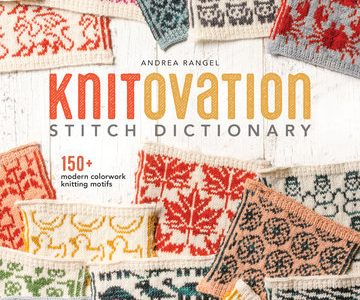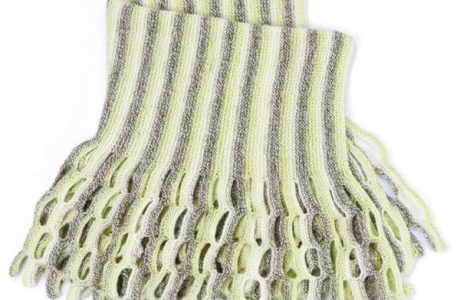
If you’re new to knitting, the language of knitting patterns might seem totally foreign to you, but there are common things you can find in well-written knitting patterns that make it easier to read and follow the knitting pattern so you can make the project successfully.
Here’s a rundown of the things you will commonly see in a knitting pattern and what they mean for you.
Pattern Basics
The first things you will see in a knitting pattern are basic information about what size it is, what kind of yarn you need and how much, what knitting needles and other supplies you might need and the gauge required.
Since I just published it recently as I am writing this, let’s look at my Easy Mosaic Cowl knitting pattern from Our Daily Craft as a guide. This is how I generally break down information when I’m writing knitting patterns, and you should find the same information — though perhaps in a different order — in most patterns you encounter.
Materials
What kind of yarn was used in the pattern? What color? If more than one color was used, which ones? How much yarn? Yardage requirements are often given as a range if there are multiple sizes involved, but yardage is always an estimate because you may knit more tightly or loosely, decide to make the project bigger or smaller, all of which would change the amount of yarn you use. This section will also include the knitting needle size or sizes used and any other required notions (such as stitch markers, holders, cable needle, etc.)
Gauge
How many stitches per inch or four inches/10 cm the designer got using the specified yarn, needle and stitch pattern. If you want your project to come out the same size you need to check your gauge and make sure you are getting the same number of stitches. If you are getting more stitches, use a larger needle; if you are getting fewer stitches, try a smaller needle. Gauge is more important than using the same needles suggested in the pattern.
Size
The finished size of the project. If multiple sizes are offered, they will be presented with the smallest size first, and increasing larger sizes following in parentheses. For example the pattern might say it comes out to 20 (24, 28, 32, 36) inches, so you would know the smallest size is 20 inches and the largest 36.
If the project is meant to fit a body, such as a hat or a sweater, it might also say what body measurement each size is intended for. For example if a pattern is designed to have positive ease, it might indicate that the actual body measurement for that size is smaller than the size of the garment.
How to Read a Knitting Pattern
Many knitting patterns look like they are written in code because the instructions are given in abbreviations rather than actual words.
This is a practice held over from when knitting patterns were mostly only available in books and magazines, and the shorthand instructions took up less space so more patterns or more and larger photos of the finished projects could be included.
In the days of digital patterns and online publishing, we have infinite room to spell out words in knitting patterns, but many designers still use the abbreviations on their patterns.
One reason for this is that patterns are just easier to read that way if you have lengthy instructions for each row or round. And for the most part knitting abbreviations are easy to decipher, such as k for knit and p for purl. If the pattern has any odd or specialized abbreviations (such as cables stitches, bobbles or a special increase or decrease) the pattern should include a key that explains how to do them.
Many of the standard abbreviations found in knitting patterns can be found on the Craft Yarn Council’s website.
Tips for Following a Knitting Pattern
Once you have picked out your yarn and gotten the correct gauge for the pattern, it’s time to start knitting. If you are working from a pattern with multiple sizes, you might want to highlight all the instructions for your size so that they are easy to find as you work.
Read through the pattern and make sure you understand all the abbreviations and instructions. Pay particular attention to whether the pattern ever asks you to do two different things at the same time, because this is easy to overlook.
If the pattern includes charts, make sure you understand what they say and how to follow them. Typically charts are read from bottom to top, and from right to left on right-side rows and left to right on wrong-side rows (with the symbols meaning the opposite on wrong side rows). If you’re working in the round all rows of the chart can be read from right to left.
You’ll also need to pay attention to repeats in the chart and whether there are stitches that only occur at the beginning or end of the row.
As you go through the pattern you may want to mark completed rows or sets of instructions to help you keep track of where you are in the pattern. If you do this, consider putting your printed pattern in a plastic sleeve so you can mark on the sleeve instead of on the pattern itself in case you have to rip back or want to make the project again.
Following a knitting pattern isn’t difficult once you understand the language. If you have any pattern-reading related problems let us know and we can help!




